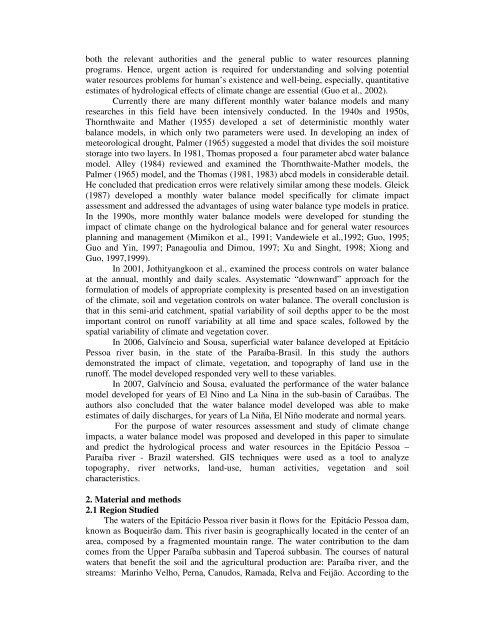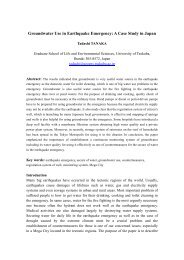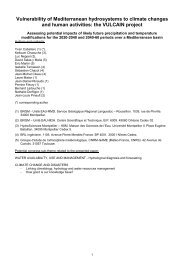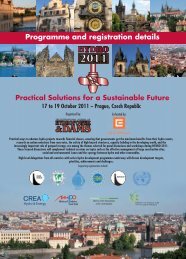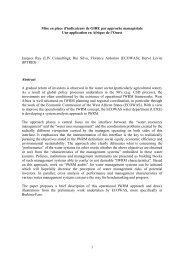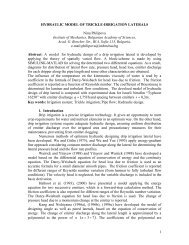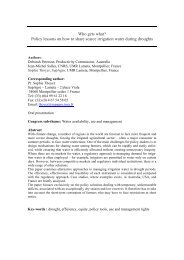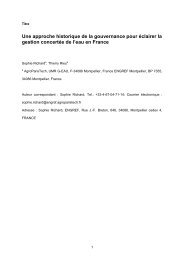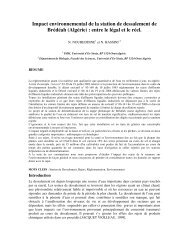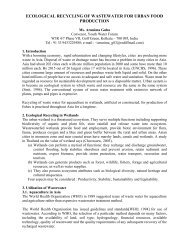WATER BALANCE MODEL TO PREDICT CLIMATE ... - IWRA
WATER BALANCE MODEL TO PREDICT CLIMATE ... - IWRA
WATER BALANCE MODEL TO PREDICT CLIMATE ... - IWRA
Create successful ePaper yourself
Turn your PDF publications into a flip-book with our unique Google optimized e-Paper software.
oth the relevant authorities and the general public to water resources planningprograms. Hence, urgent action is required for understanding and solving potentialwater resources problems for human’s existence and well-being, especially, quantitativeestimates of hydrological effects of climate change are essential (Guo et al., 2002).Currently there are many different monthly water balance models and manyresearches in this field have been intensively conducted. In the 1940s and 1950s,Thornthwaite and Mather (1955) developed a set of deterministic monthly waterbalance models, in which only two parameters were used. In developing an index ofmeteorological drought, Palmer (1965) suggested a model that divides the soil moisturestorage into two layers. In 1981, Thomas proposed a four parameter abcd water balancemodel. Alley (1984) reviewed and examined the Thornthwaite-Mather models, thePalmer (1965) model, and the Thomas (1981, 1983) abcd models in considerable detail.He concluded that predication erros were relatively similar among these models. Gleick(1987) developed a monthly water balance model specifically for climate impactassessment and addressed the advantages of using water balance type models in pratice.In the 1990s, more monthly water balance models were developed for stunding theimpact of climate change on the hydrological balance and for general water resourcesplanning and management (Mimikon et al., 1991; Vandewiele et al.,1992; Guo, 1995;Guo and Yin, 1997; Panagoulia and Dimou, 1997; Xu and Singht, 1998; Xiong andGuo, 1997,1999).In 2001, Jothityangkoon et al., examined the process controls on water balanceat the annual, monthly and daily scales. Asystematic “downward” approach for theformulation of models of appropriate complexity is presented based on an investigationof the climate, soil and vegetation controls on water balance. The overall conclusion isthat in this semi-arid catchment, spatial variability of soil depths apper to be the mostimportant control on runoff variability at all time and space scales, followed by thespatial variability of climate and vegetation cover.In 2006, Galvíncio and Sousa, superficial water balance developed at EpitácioPessoa river basin, in the state of the Paraíba-Brasil. In this study the authorsdemonstrated the impact of climate, vegetation, and topography of land use in therunoff. The model developed responded very well to these variables.In 2007, Galvíncio and Sousa, evaluated the performance of the water balancemodel developed for years of El Nino and La Nina in the sub-basin of Caraúbas. Theauthors also concluded that the water balance model developed was able to makeestimates of daily discharges, for years of La Niña, El Niño moderate and normal years.For the purpose of water resources assessment and study of climate changeimpacts, a water balance model was proposed and developed in this paper to simulateand predict the hydrological process and water resources in the Epitácio Pessoa –Paraíba river - Brazil watershed. GIS techniques were used as a tool to analyzetopography, river networks, land-use, human activities, vegetation and soilcharacteristics.2. Material and methods2.1 Region StudiedThe waters of the Epitácio Pessoa river basin it flows for the Epitácio Pessoa dam,known as Boqueirão dam. This river basin is geographically located in the center of anarea, composed by a fragmented mountain range. The water contribution to the damcomes from the Upper Paraíba subbasin and Taperoá subbasin. The courses of naturalwaters that benefit the soil and the agricultural production are: Paraíba river, and thestreams: Marinho Velho, Perna, Canudos, Ramada, Relva and Feijão. According to the


